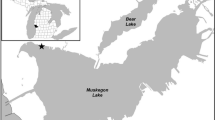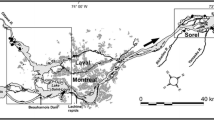Abstract
Water flow and flooding duration in wetlands influence the structure and productivity of microbial communities partly through their influence on nutrient loading. The effect of flow-regulated nutrient loads is especially relevant for microbial communities in nutrient-poor settings, where delivery controls nutrient uptake rates and the intensity of microbial interactions. We examined the effect of hydrologic history and proximity to water sources on nutrient enrichment of benthic microbial assemblages (periphyton) and on their diatom species composition, along the artificial boundaries of Taylor Slough, a historically phosphorus-depleted drainage of the Florida Everglades. Concentrations of phosphorus in periphyton declined from the wetland boundary near inflow structures to 100-m interior, with spatial and temporal variability in rates dependent on proximity to and magnitude of water flow. Phosphorus availability influenced the beta diversity of diatom assemblages, with higher values near inflow structures where resources were greatest, while interior sites and reference transects contained assemblages with constant composition of taxa considered endemic to the Everglades. This research shows how hydrologic restoration may have unintended consequences when incoming water quality is not regulated, including a replacement of distinctive microbial assemblages by ubiquitous, cosmopolitan ones.






Similar content being viewed by others
References
Armentano TV, Sah JP, Ross MS, Jones MS, Jones DT, Cooley HC, Smith CS (2006) Rapid responses of vegetation to hydrological changes in Taylor Slough Everglades National Park, Florida, USA. Hydrobiologia 569:293–309
Batzer DP, Sharitz RR (2007) Ecology of Freshwater and Estuarine Wetlands. University of California Press, Berkeley
Bramburger A, Munyon J, Gaiser E (2013) Water quality and wet season diatom assemblage characteristics from the Tamiami Trail pilot swales sites. Phytotaxa
Chase JM (2007) Drought mediates the importance of stochastic community assembly. Proc Nat Ac Sciences (USA) 104:17430–17434
Chase JM (2010) Stochastic community assembly causes higher biodiversity in more productive environments. Science 328:1388–1391
Childers DL, Doren R, Jones R, Noe GB, Rugge M, Scinto LJ (2003) Decadal change in vegetation and soil phosphorus pattern across the Everglades landscape. J Environ Qual 32:344–362
Donohue I, Jackson AL, Pusch MT, Irvine K (2009) Nutrient enrichment homogenizes lake benthic assemblages at local and regional scales. Ecology 90:3470–3477
Doren RF, Trexler JC, Gottlieb AD, Harwell M (2009) Ecological indicators for system-wide assessment of the Greater Everglades Ecosystem Restoration Program. Ecol Indic 9:S2–S16
Dufrene M, Legendre P (1997) Species assemblages and indicator species: the need for a flexible asymmetrical approach. Ecol Monogr 67:345–366
Finlayson CM, Bellio MG, Lowry JB (2005) A conceptual basis for the wise use of wetlands in northern Australia—linking information needs, integrated analyses, drivers of change and human well-being. Mar Freshw Res 56:269–277
Gaiser E, Scinto L, Richards J, Jayachandran K, Childers D, Trexler J, Jones R (2004) Phosphorus in periphyton mats provides best metric for detecting low-level P enrichment in an oligotrophic wetland. Water Res 38:507–516
Gaiser E, Richards J, Trexler J, Jones R, Childers D (2006) Periphyton responses to eutrophication in the Florida Everglades: Cross-system patterns of structural and compositional change. Limnol Oceanogr 51:617–630
Gaiser EE, McCormick P, Hagerthey SE (2011) Landscape patterns of periphyton in the Florida Everglades. Crit Rev Environ Sci Technol 41(S1):92–120
Hasle G, Fryxell G (1970) Diatoms: Cleaning and mounting for light and electron microscopy. Trans Am Microsc Soc 89:470–474
HydroGeologic, Inc. (2010) Surface water groundwater flow and transport model development for the eastern boundary of Everglades National Park. Report submitted to the South Florida Ecosystem Office, Everglades National Park, and Florida International University
Iwaniec DM, Childers DL, Rondeau D, Madden CJ, Saunders CJ (2006) Effects of hydrologic and water quality drivers on periphyton dynamics in the southern Everglades. Hydrobiologia 569:223–235
Johnson LB, Host GE (2010) Recent developments in landscape approaches for the study of aquatic ecosystems. J N Am Bentholl Soc 29:41–66
Junk WJ, Brown M, Campbell IC, Finlayson M, Gopal B, Ramberg L, Warner BG (2006) The comparative biodiversity of seven globally important wetlands: a synthesis. Aquatic Science 68:400–414
Limberger R, Wickham SA (2012) Disturbance and diversity at two spatial scales. Oecologia 168:785–795
Matthews JW, Peralta AL, Flanagan DN, Baldwin PM, Soni A, Kent AD, Endress AG (2009) Relative influence of landscape vs. local factors on plant community assembly in restored wetlands. Ecol Appl 19:2108–2123
Mitsch WJ, Gosselink JG, Anderson CJ, Zhang L (2009) Wetland Ecosystems. Wiley, New York
McVoy CW, Said WP, Obeysekera J, Arman JV, Dreschel T (2011) Landscapes and Hydrology of the Predrainage Everglades. University Press of Florida, Gainesville
Pan Y, Stevenson RJ, Hill BH, Herlihy AT (2000) Ecoregions and benthic diatom assemblages in Mid-Atlantic Highlands streams, USA. J N Am Bentholl Soc 19:518–540
Raschke RL (1993) Diatom (Bacillariophyta) community response to phosphorus in the Everglades National Park, USA. Phycologia 32:48–58
Reddy KR, Osborne T (2007) Water Conservation Areas–transect soil sampling. Institute of Food and Agricultural Sciences. University of Florida, Gainesville
Sah J, Ross M, Saha S, Minchin P, Sadle J (2013) Trajectories of vegetation response to water management in Taylor Slough, Everglades National Park, Florida. Wetlands (this issue)
SFNRC (2005) An assessment of the interim operational plan. South Florida Natural Resource Center, Everglades National Park, Homestead, FL. Project evaluation report. SFNRC technical series 2005:2, p 47
Slate JE, Stevenson RJ (2007) The diatom flora of phosphorus-enriched and unenriched sites in an Everglades marsh. Diatom Research 22:355–386
Soininen J, Kokocinski M, Estlander S, Kotanen J, Heino J (2007) Neutrality, niches, and determinants of plankton metacommunity structure across boreal wetland ponds. Ecoscience 14:146–154
Solorzano L, Sharp JH (1980) Determination of total dissolved P and particulate P in natural waters. Limnol Oceanogr 25:754–758
Sokol E, Hoch J, Gaiser E, Trexler J (2013) Metacommunity structure along resource and disturbance gradients in Everglades wetlands. Wetlands (this issue)
Sullivan P, Gaiser E, Surratt D (2013) Wetland Ecosystem Response to Hydrologic Restoration and Management: The Eastern Everglades (FL, USA). Wetlands
Somer U (1984) The Paradox of the Plankton: Fluctuations in phosphorus availability maintain diversity of phytoplankton in flow-through cultures. Limnol Oceanogr 29:633–636
Surratt D, Shinde D, Aumen N (2011) Recent cattail expansion and possible relationships to water management: changes in upper Taylor Slough (Everglades National Park, USA). Environ Manag 49:720–733
Thomas S, Gaiser E, Gantar M, Scinto L (2006) Quantifying the responses of calcareous periphyton crusts to rehydration: A microcosm study (Florida Everglades). Aquat Bot 84:317–323
U.S. Environmental Protection Agency (1983) Methods for chemical analysis of water and wastes. Revision March 83, method 365.1. U.S. Environmental Protection Agency.
Vanormelingen P, Verleyen E, Vyverman W (2007) The diversity and distribution of diatoms: from cosmopolitanism to narrow endemism. Biodivers Conserv 17:393–405
Van Lent T, Johnson R, Fennema R (1993) Water management in Taylor Slough and effects on Florida Bay. South Florida Research Center, Everglades National Park, Homestead, FL. http://www.nps.gov/ever/naturescience/technicalreports.htm. Accessed 22 Jun 2012
Warwick RM, Clarke KR (1993) Increased variability as a symptom of stress in marine communities. J Exp Mar Biol Ecol 172:215–226
Acknowledgements
This project was funded by cooperative agreement Cooperative Agreement H5000060104, Task No. J5284060023 and J5297080001 between Everglades National Park (ENP) and Florida International University. This publication was produced as part of a special issue devoted to investigating the ecological response of over 20 years of hydrologic restoration and active management in the Taylor Slough drainage of Everglades National Park. Support for this special issue was provided by the Everglades National Park, the Southeast Environmental Research Center, the Florida Coastal Everglades Long-Term Ecological Research program (under National Science Foundation Grant Nos. DEB-9910514 and DBI-0620409), the Everglades Foundation and the South Florida Water Management District. This is contribution number 597 of the Southeast Environmental Research Center. We thank Josette La Hée and Jorge Carreno for assistance counting and identifying diatoms for this project, Rafael Travieso, Felipe Zuniga and Catherine Hamilton for help in the field and laboratory, and collaborators Alicia LoGalbo, René Price, Len Scinto, Dilip Shinde, Donatto Surratt, and Mike Zimmerman for helpful discussions about this work.
Author information
Authors and Affiliations
Corresponding author
Electronic supplementary material
Below is the link to the electronic supplementary material.
ESM 1
(DOC 475 kb)
Rights and permissions
About this article
Cite this article
Gaiser, E.E., Sullivan, P., Tobias, F.A.C. et al. Boundary Effects on Benthic Microbial Phosphorus Concentrations and Diatom Beta Diversity in a Hydrologically-modified, Nutrient-limited Wetland. Wetlands 34 (Suppl 1), 55–64 (2014). https://doi.org/10.1007/s13157-013-0379-z
Received:
Accepted:
Published:
Issue Date:
DOI: https://doi.org/10.1007/s13157-013-0379-z




